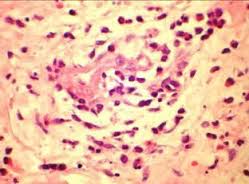
Epidemiology. Is about 20% of all vasculitis.
Clinical manifestations.
In the course of the disease conditionally distinguish 3 main phases.
The first phase or prodromal period can last up to 30 years. manifestations
- Various allergic reactions: rhinitis, hay fever and astma.
Second leg
- Blood and tissue eosinophilia.
- Loeffler syndrome,
- Eosinophilic pneumonia or eosinophilic gastroenteritis.
In the third phase of the clinical picture of the disease to the forefront signs of systemic vasculitis.
Manifestation of disease
Syndrome of bronchial hyperreactivity. In most cases, it precedes the clinical manifestations of systemic vasculitis. Often there is connection with the development of pulmonary infection infectious-dependent forms of asthma and BEB. Pulmonary infiltrates detected in two-thirds of patients. One third of the patients revealedpleurisy with eosinophilia in the pleural fluid.
Gastrointestinal: abdominal pain, diarrhea, and sometimes bleeding. Complications: intestinal perforation, peritonitis, intestinal obstruction.
Cardio-vascular system: various ECG changes detected in almost half of patients who develop acute orconstrictive pericarditis, cardiac failure.
Changes in the skin are one of the most characteristic symptoms of the disease. These include nodules, purpura, erythema, urticaria, skin necrosis, and livedo reticularis.
Renal disease occurs less malignant than in Wegener's granulomatosis or UP. May develop nephritis.
Joint damage in the form of arthritis or polyarthralgia. Characteristic not progressing migratory arthritis of large and small joints. Occasionally there are myalgia and myositis.
Diagnostics.
The main diagnostic markers Churg-Strauss syndrome are:
1) patients with predominantly female;
2) fever and weight loss;
3) BA (at the time of inspection or in history);
4) can be GBV (proteinuria, microscopic hematuria without renal dysfunction).
5) myalgia;
6) abdominal pain;
7) polyneuritis;
8) eosinophilia (15-85% eosinophils in the peripheral blood).
9) AT to the cytoplasm of neutrophils in the blood serum
Observed correlation between the level of eosinophilia and severity of clinical manifestations of asthma andvasculitis. Occur normochromic normocytic anemia, leukocytosis, accelerated ESR and CRP increase. Inpatients with single-and gipokomplementemiya increase in CEC.
Differential Diagnosis
- Wegener's granulomatosis,
- Chronic eosinophilic pneumonia
- Idiopathic hypereosinophilic syndrome
Treatment
Depending on severity of the disease, prednisolone administered in a dose of 40-60 mg / day for several weeks, with a gradual decline. Despite the relative goodness of the inflammatory process, achieving a clinical effect is often necessary long-term use of high doses of the drug. Cancel GCS possible not earlier than one year from the start of treatment.
The lack of effectiveness of prednisolone use cyclophosphamide, azathioprine, hlorbutin in conventionaldosages.

